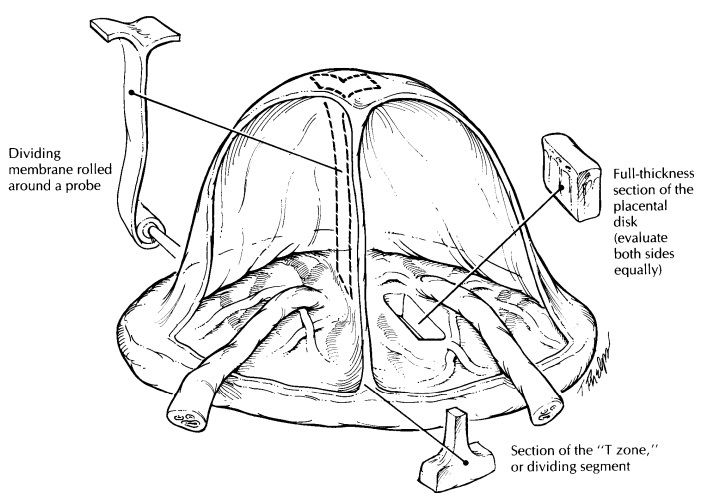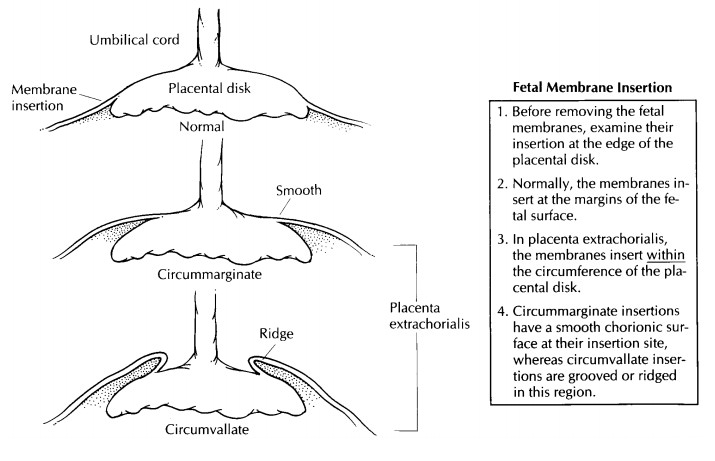Chapter: Surgical Pathology Dissection : The Female Genital System
Products of Conception : Surgical Pathology Dissection
Products of Conceptionand Placentas
Products of Conception
Products of conception is the
term used for intra-uterine tissue that is either passed spontaneously or
removed surgically in early gestation. These specimens are usually sent for
diagnostic or ther-apeutic purposes. The major goal is to verify that a
gestation was present. This requires the identifi-cation of either fetal parts,
chorionic villi, or tro-phoblastic cells. The presence of decidua alone is not
sufficent for diagnosis. Molar pregnancies and placental neoplasia may also be
identified, although these are much less common. Always be familiar with the
patient’s clinical history, as this will help guide your examination.
Specimens
from first trimester gestations are usually composed of irregularly shaped
small tissue fragments and blood clots suspended with-in a fluid-filled
container. Strain the entire con-tents of the container, and give an estimate
of the amount of the specimen by volume (in cubic centimeters) or as an
aggregate measurement. Spread the specimen across your work bench, and separate
the blood clots from the tissue. Care-fully inspect the tissue for fetal parts
and vil-lous tissue. Villous tissue is soft and spongy, whereas decidua is more
likely to be firmer and membranous. Another method of examination is to suspend
the tissue fragments in saline. The delicate villous fronds will then become
readily apparent. Also, look for evidence of swollen or hydropic villi, which
appear as small, grape-like vesicles.
If fetal
parts are identified, measure them sepa-rately, and submit several pieces along
with rep-resentative villous tissue in one or two tissue cassettes. If no fetal
parts are identified and you are confident of your identification of villi,
submit representative sections in two or three tissue cas-settes. However,
because the confirmation of an intrauterine pregnancy is often needed
immedi-ately, it may be wise to use the following guide-line: Submit the entire
specimen if it is small or as much as can be included in five tissue cassettes.
Always specify the percentage of the specimen that was submitted, and include
only tissue fragments. We have found that the microscopic evaluation of blood
clots from intrauterine preg-nancies often does not reveal entrapped villi. If
no villi are identified after your initial micro-scopic evaluation, the entire
specimen may need to be submitted.




In the
case of a clinically suspected molar pregnancy or the presence of hydropic
villi, the submission of at least eight tissue cassettes is recommended to
assess the degree of trophoblast proliferation. Any large tissue fragments,
that is, fragments greater than 3 to 4 cm, should be sec-tioned and entirely
submitted if they are firm, indurated, or necrotic. Consider sending fresh
tissue for flow cytometric ploidy analysis or tissue culture cytogenetic
analysis. Partial moles are triploid, whereas complete moles are diploid or
tetraploid. Uterine resection specimens for gestational trophoblastic malignancies
should be handled as for hysterectomies for endometrial or cervical cancer
depending on the site of the tumor.
Second
trimester therapeutic or elective abor-tion specimens may have intact placentas
and fetuses. These specimens may be handled in the routine surgical pathology
laboratory if the fetus is less than 500 g and/or less than 20 to 21 weeks’
gestation. however, most cases can be appropriately han-dled with a limited
approach. Briefly, weigh the fetus, and measure the crown–rump, crown–heel, and
foot length. Examine the external appearance for skin slippage and any gross
abnormalities of structure such as missing limbs or extra digits. Open the
thorax and abdomen with a vertical midline incision. Confirm the appropriate
posi-tion of the internal organs, and take a piece of liver, lung, and gonads
for microscopic evalua-tion. For the examination of a fetus with either
chromosomal or congenital abnormalities, the reader is referred to Wigglesworth
and Singer.14 The placenta can be routinely handled, as de-scribed in the next
section.
Related Topics